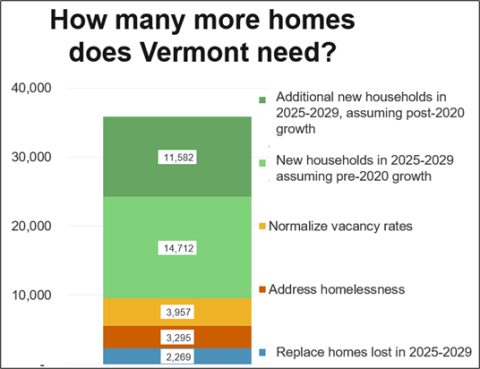Last week the Vermont Department of Housing and Community Development (DHCD) announced the publication of the Vermont 2025-2029 Statewide Housing Needs Assessment, a five-year document the U.S. Department of Housing and Urban Development (HUD) requires from government entities that receive federal funding. The findings in the report show Vermont’s statewide housing shortage remains and the affordability gap is growing as costs stretch Vermonters’ budgets thin.

DHCD contracted with the VHFA research team to complete the Vermont 2025-2029 Statewide Housing Needs Assessment.
“Vermont’s affordability crisis is directly tied to a lack of housing,” said Governor Phil Scott in the announcement press release. “We cannot successfully grow our economy, address significant challenges in our healthcare and education systems, or improve quality of life for Vermonters without an adequate supply of housing across the entire state. My Administration is committed to improving and increasing our housing stock, which this Housing Needs Assessment shows is drastically needed.”
The Housing Needs Assessment, along with the mandated 2024 Fair Housing Analysis (expected to be published this fall by DHCD), informs the statewide Consolidated Plan that HUD approves for federal funding. The Housing Needs Assessment is also increasingly used by state and local officials to inform policy and spending decisions that address housing needs in our communities.
“Our housing policy should be about creating more opportunities for Vermonters to be able to find a place to live,” said DHCD Commissioner Alex Farrell. “Taxpayers dollars alone is not enough to build at least 24,000 units in the next five years, so we need to work with our public and private sector partners to accelerate unit generation in every corner of the state.”
To see the Vermont 2025-2029 Housing Needs Assessment click here. The assessment includes 10 issue-specific fact sheets and corresponding detailed report chapters as well as 14 chapters pertaining to county-level housing needs.
Key Findings in the 2025-2029 Report
- Vermont’s housing shortage deepened in 2020, with rippling economic and social impacts. Between 2025 and 2029, Vermont will likely need 24,000-36,000 additional year-round homes. Currently, there are approximately 272,000 year-round homes in Vermont.
- Low-income households and renters are hardest hit by the housing shortage. 25% of renters are paying more than half their income for housing and a shrinking portion of renters can afford to buy homes. Approximately 17,000 renter households are considered “severely cost burdened” by housing costs.
- About 20,000 Vermont homes have indications of housing quality vulnerabilities, many of which have low-income owners with few funds for repairs. These account for 7% of the year-round housing stock.
- The segment of Vermont residents with needs for service-enriched housing is growing. The number of Vermonters who are aged 75 and up is rising at the same time that Vermont struggles with higher than average rates of addiction disorder and disability.

